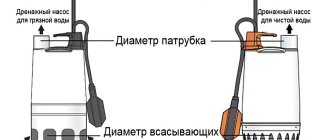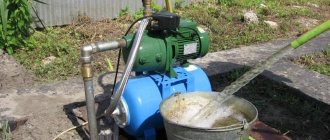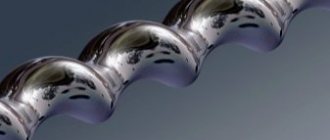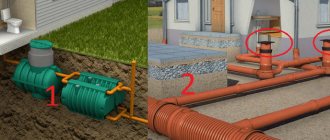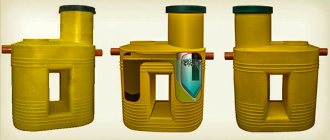The pace of development of electrical engineering and electronics suggests the entry into the market of modern powerful pumps for wells powered by electricity. They are capable of pumping up to 3 cubic meters of water per hour, which will fully meet the needs of a private or country house. Their disadvantage is their dependence on a source of electrical energy.
Where there is no electricity, water hand pumps are used for wells, which will become a full-fledged backup source of water in a specially drilled well.
Features of operating hand pumps
Hand pumps are designed for drawing water from a depth of 7 to 30 m inclusive. Thanks to the material, the use of steel and bronze, the device can operate for many years without repair or maintenance. The pumps are resistant to mechanical damage, mold and mildew corrosion, and can operate in chemically active environments.
The design of a typical unit includes:
- cover;
- movable shaft;
- suction device;
- lever arm.
A hand pump pushes water to the surface under pressure, which is created by the movement of air during the mechanical movements of the handle.
You should purchase a mechanical pump if your purchase falls under one of the following conditions:
- It is planned to organize a backup water source in an area with low consumption.
- There are no electrical communications to install an electric pump.
- There is no need to drill a well, since there is a well or reservoir on the site.
- There is a task to equip a public water pump or organize a source of backup water intake in case of fire.
Scope of application of a hand pump and its advantages
A mechanical pump can be used to lift water from any body of water.
The scope of application of structures of this type includes:
- Water supply at home for economic and domestic needs.
- Collecting dirty or clean water from a reservoir for convenient and quick watering of garden crops.
- Transporting water to greenhouses.
- Drainage of flooded premises.
The disadvantages of manual pumping include low productivity (compared to automatic models, manual devices supply a smaller volume of water) and the need to exert physical effort when pressing the handle.
However, the manual method has a number of positive aspects:
- The system can be installed in any conditions.
- Installing the pump does not take much time and is not complicated.
- Launch does not require the involvement of outside specialists.
- All components and components of the mechanism must be replaced.
- Manual pumping does not require connection to the electrical network, so it can be used even in areas where there is no electricity.
The hand pump easily withstands changes in temperature.
Another advantage is the lower cost of the manual mechanism compared to other types. Thanks to the metal body, the mechanism does not require additional canopies. It will not fail when exposed to low temperatures and adverse weather conditions.
On a plot of land, installation is carried out above a well, the depth of which must correspond to the type of pump.
Advantages and disadvantages
Like any device, a manual well pump has advantages and disadvantages. Disadvantages include the need for maintenance, since the mechanical parts will have to be inspected and lubricated from time to time.
Among other disadvantages, one can highlight the rather large force with which pressure is applied to the lever. This is why the device may be inconvenient for older people and children.
When the number of pumpings decreases, the intensity of water supply and pressure level decreases.
The advantages include the lack of special knowledge, since you do not need to be a specialist to install the device. The fact is that, according to the principle of operation, a hand pump for a well resembles a water cooler, where its younger version is used. The positive side is the opportunity, with a small investment of money, to establish a water supply at the dacha or in the house.
arrangement and production of an Abyssinian well (well) for a hand pump
For a hand pump, the best solution would be to make an Abyssinian well or borehole. In most cases, such wells reach a depth of up to 9 meters. Based on these parameters, most similar devices were created. At this depth, in most cases, there is a good aquifer, which makes it possible to provide a suburban area with drinking water. Moreover, this can be used for construction work.
If you watch a video about making an Abyssinian well, you will immediately see that it is possible to make it yourself, but there is a possibility that you will not cope with the task. And the reason for this will not be that you are a bad master, perhaps you simply won’t be able to find water, or other troubles will appear. You can verify this by watching a video where all the rules of work were followed, but home craftsmen failed.
Video: making an Abyssinian well using the driving method - a bad experience
As can be seen from the video, all the details of the work were observed, but as a result it was not possible to clog the pipe; it broke off. Despite the fact that it is also possible that there simply was not enough experience in performing these works. Moreover, part of the pipe remained in the ground. Given this, it is worth carefully thinking about everything and weighing the pros and cons.
A critical condition for making an Abyssinian well is the composition of the soil. It should be mainly sandy or made up of sand and a mixture of crushed stone. If your soil is rocky, you won’t be able to get deeper on your own unless you make a drilling rig yourself. But not everyone can do this. Based on this, they usually lead to specialists for help. If the soil is mostly sandy, then the work on arranging and manufacturing an Abyssinian well can be done with one’s own hands. Based on this, we will further tell you about driving technology, since the drilling technology is mainly used by experts. You can watch prepared videos on this topic.
Video: what is an Abyssinian well and how to make it
Advantages of the Abyssinian well
To begin with, let’s present a real picture of what specific advantages such a well has when compared with analogues:
| Benefits of the Abyssinian well | |
| Economical | Today, the price of making a well will cost you a little more than 20 thousand rubles. Along with this, you will not need to rent a lot of equipment. In most cases, experts come in their own car and bring all the equipment in a small volume. If you decide to make a well yourself, then in general, preparing and assembling the necessary equipment will not cost you as much, unless you decide to make a homemade drilling rig. If the driving method is chosen, you will need about 10 thousand rubles to purchase the necessary equipment. Despite the fact that a lot of hardening will need to be done, the result will not leave you indifferent. |
| simplicity and speed | There is no need to construct a drilling derrick and tripod at all. On the territory of the Russian Federation, the aquifer lies at a depth of 2 to 15 meters. If the ground is mostly sandy, then two strong men can do it in one day (in some cases in a couple of hours). Moreover, if the drill gets stuck or hits a stone, it is easy to remove it yourself. But there are also bad experiences when the pipe may break (you had the opportunity to look at this in the video above in the article). |
| Environmental friendliness | If your home is located far from the city, then it is possible to find good water at such a depth, which will be fully suitable for drinking. At the same time, its quality will not be inferior to water located in deeper aquifers. |
| Duration of operation | If all manufacturing conditions are met, the service life can be about 30 years, provided that the water does not run out. Based on this, the duration depends on the debit of the source. |
| Lack of obtaining permits | This is perhaps the main advantage of the Abyssinian well. No permits are required to manufacture it. Permits are required for an artesian well, but not required for an Abyssinian well. |
Conducting geological studies
The first thing you need to do is study the geology of your area. If your neighbors live next to you, you can ask them what the condition of the soil is and at what depth the water lies. Troubles will not appear if the aquifer lies at a depth of no more than 9 meters. If the depth is greater, then using a hand pump is problematic.
Basically, the aquifer consists of medium-grained sand or sand with small crushed stone. It is through such soil that water will flow perfectly. Now it is fundamentally important to find out what is the best way to drill, either by driving or by drilling.
Which drilling method is better: drilling or driving?
If you decide to make a well yourself, then a driven well is a suitable option. For this purpose, a “hammering woman” is used. But there is always the possibility of passing by the aquifer. What if a stone is encountered at depth, the entire structure may be damaged.
If you choose a drilling method, then it is better to turn to experts. Under such conditions, you have a great chance of getting an Abyssinian well with water. You have the opportunity to watch videos where this method is demonstrated.
Video: Well Drilling Development
In addition, we invite you to familiarize yourself with the development of well manufacturing using the driven method. That is why you can compare all labor costs.
Video: making a well using the driving method
What is needed to make an Abyssinian well
First of all, you should prepare all the equipment and necessary material. The main equipment is presented in the table:
| Equipment | Purpose |
| Needle | A needle means a metal cone or point. You can make the tip yourself on a lathe or order it from a craftsman. The diameter of the needle should be 20 mm larger than the diameter of the pipe being installed. The length is not less than 200 and more than 300 mm. The needle is soldered to the pipe or screwed into the thread. If you decide to solder it, then you cannot use lead (it is possible to poison the water). For solder, use tin. |
| Filter | It keeps sand out of the clean water pipe. A filter in the form of a pipe is placed at the very bottom of the well. It is possible to do it yourself, you will determine this further. |
| Sections (pipeline) | They are connected to each other by thread using a coupling. But it is fundamentally important that the connection be airtight. For ease of operation, one section of the pipe should have a length of no more than 1 meter. |
| Pump | Once the well is completed, a hand pump is installed. If funds allow, it is possible to install an electric one. |
Making a filter for water purification
For production you will need a pipe 110 cm long and 1 inch in diameter. It is possible to solder or weld a needle onto one end of the pipe. Alternatively, it is possible to cut the pipe and flatten the end. You need to make holes Ø13 mm in the pipe in 50 cm increments in a checkerboard pattern.
Then an iron filter mesh is applied and tightened with clamps every 10 cm. For this, it is possible to use stainless or galvanized wire Ø3 mm.
Finally, the wire is fixed into the pipe with a self-tapping screw. You can see this in the figure below:
This is how you can make a homemade filter. Of course, if you have the materials and time for this.
Types of hand pumps
Modern production involves the production of hand pumps of various configurations. These are piston devices, rod-type mechanisms, impellers and pumps, as well as units with a membrane in the structure. A few words about each variety:
- Piston type pump. This device has been in use longer than others. The working mechanism is a cylinder and a piston. The design has two valves. By applying pressure to the handle, one valve opens, the other closes, and under the influence of pumped air, water is supplied to the surface under pressure. With one press of the lever, the piston mechanism can pump up to 3 liters.
Piston type hand pump
- Rod pump. The difference between hand pumps and pumps from other varieties is the ability to pump water from a depth of up to 30 meters. Therefore, they can be installed both in a regular well and in a sand well. The design of such a device is almost identical to the piston mechanism, but only the piston and cylinder itself are more elongated, which increases the pressure during one pumping of the rod. Among the disadvantages of the device is the possibility of the rod breaking over time.
Manual water pump with rod pump
- Wing system. This design looks different than the previous configuration. There are wings, a valve, a suction type element, and a shaft. There is a handle that you turn. As a result, pressure is created in the circuit and water is supplied to the surface.
Hand water pump with vane system
- Diaphragm pump. Its design is the most durable of all. It assumes the ability to pump not only clean water, but also water with sand and other inclusions. In this case, the structure does not become clogged, since the mechanism provides for self-cleaning due to balls rolling inside the device.
Diaphragm hand pump
Overview of the operation of manual piston water pump:
Other types of mechanical pumps
When the efficiency of the pump mechanisms considered is low, there is sometimes a need for additional developments. Other types of structures are often used when pumping water from various reservoirs.
Archimedes screw
The ideological creator of the design is Archimedes. The basis of the mechanism is a pipe in the form of a cylinder, in the cavity of which a screw is located. The design is placed at a slight angle, so it is used on open sources. As the blades rotate, they pick up water and push it to the surface.
An electric screw pump works in a similar way. It is used to continuously draw water from deep sources.
Archimedes screw.
Hydraulic ram
The creator of this water intake mechanism is Montgolfier. The hydraulic device lifts water using kinetic energy. The design principle is based on the following:
- The water flow is blocked by a valve.
- There is a tank on top into which water flows under pressure.
- From it, the liquid enters the hose and is delivered to its destination.
The operation of the structure is based on repeating cycles.
Airlift
The airlift mechanism was developed by Karl Loscher. The principle of operation is based on pushing water out with air through a hollow pipe, which is lowered into the source.
At the bottom there is an inlet section of the pipe through which air is pumped through the nipple. This prevents water from entering the hose. Bubbles are formed, they dissolve in the aqueous environment and create a light weight of the liquid. The bubbles move upward along with the water.
Instead of a hand pump, you can use a compressor if there is electricity in the area.
Tips for choosing
So now we know what a hand pump is and want to purchase one for our own use. To do this, you need to know the basic nuances that will help you make the right choice.
Firstly, it is necessary to take into account the depth from which the pump will draw water. The average model is designed for a water rise depth of 10 m. If the well is deep, purchase rod options, as they are capable of pumping water from a well depth of up to 30 meters.
Another criterion is the volume of water that the pump can pump per unit of time. Also, consider the diameter of the casing. If in your case the pipe diameter is at least 100 mm, then you don’t have to worry about this criterion. Absolutely any model will do.
Take a water sample and take it to the laboratory, which will determine the contamination of the water. Based on the results of the inspection, if the well is contaminated, it is best to purchase a manual pump for water from a membrane-type well.
It not only copes with pumping foreign matter, but also self-cleans due to metal balls in the design of the device.
Look at the reviews, determine for yourself the rigidity of the handle, which will allow you to orient the hand pump not only to an adult, but also to elderly people with children. Pay attention to the design of the hand pump. If you purchase a model to work only in the summer, then it is better not to overpay and give preference to the plastic option.
If it will stand permanently, then the body must be made of cast iron, steel or stainless steel. Depending on your own preferences, select a hand pump for a well based on aesthetic characteristics.
Pump classification
Nowadays, it is quite common to find water intake standpipes in yards or in the private sector. Such speakers have nothing in common with manual mechanical pumps. Because of which? In simple standpipes, water pressure is created using the pressure in the municipal water supply. In a mechanical pump, pressure is created using pressure, which is invariably pumped up by applying physical hardening.
All mechanical pumps are classified into 4 main groups:
- Piston.
- Rod
- Membrane.
- Winged.
Piston ones are used for sources up to ten meters deep. If the well depth is 30 m, then rod devices are perfect. Membranes are mainly used for pumping water in water supply systems. As for vane hand pumps, this is the most expensive device. It is a rotary mechanism in a housing with a suction pipe.
In addition, hand pumps differ in operating mode and materials of manufacture. For example, some models can only be used in the summer. The housings of such pumps can be made of plastic. In addition, there are also iron models of devices that need to be insulated for use in winter.
Now we invite you to familiarize yourself in more detail with all types of similar devices used to lift water from a well.
How to make a hand pump for a well with your own hands?
Another manual well pump - a diaphragm - can be made on the basis of a brake chamber. Only one hole needs to be left in it, the rest are clogged. On the opposite side of the remaining open hole, it is necessary to make several holes in which check valves will be installed using epoxy resin.
The valves are made from thick-walled copper tube. At one end, its internal diameter is increased using a drill, after which a ball is placed here. Its diameter should be equal to the increased (reamed) diameter of the tube, as a result of which the narrow part of the tube will be clogged. Then a piece of wire is soldered to the drilled end of the tube so that it does not allow the ball to fall out - and the valve is ready.
Hand pump for raising water
Another valve is done in the same way, only a spring is soldered to the wire, which will hold the ball closed - you get a normally closed check valve.
All that remains is to install the valves in the chamber and glue to it a round rubber membrane cut from a car inner tube. A rod is secured in the center of the membrane with nuts, the free end of which is released into the hole in the brake chamber that is left open.
Construction of a homemade piston pump for wells
The piston type pump is the easiest to manufacture. Its working mechanism has already been described, it remains to clarify a couple of details:
- It is not the housing-sleeve that should be lowered into the water, but the suction hose attached to its lower part.
- The rod should be attached to the lever - then it will be easier to lift the piston.
- A shut-off valve or check valve must be installed between the outlet pipe and the water pipe to prevent liquid from flowing out of the pipe back into the pump when it is idle.
Construction of a homemade piston pump for wells
Here is an approximate procedure for the wizard:
The body is being manufactured
The blank used is a pipe 600–800 mm long with an internal diameter of 80 mm, the inner surface of which should be as smooth as possible. The ideal option is a cylinder from an internal combustion engine or a hydraulic cylinder. If a regular pipe is used, the inside should be treated with a scraper.
A hole should be cut in the side of the upper part of the housing and the outlet pipe should be welded.
A submersible pump must be chosen especially meticulously. Aquarius pump - technical characteristics and quality assessment, read on.
For instructions on how to build a decorative well with your own hands, follow the link.
You can read all about repairing submersible pumps with your own hands in this publication.
Making caps
Lids can be made from any available material - rolled steel, plastic and even wood.
The last option is the simplest and at the same time effective: when saturated with moisture, the wood swells and is therefore securely fixed in the pipe.
It is best to make lids from larch or oak.
In the one that will be installed in the upper part of the pump, you need to drill a hole for the rod; in the lower one - install a check valve.
Making a piston
The piston, like the caps, can be made from anything. It is important that it has a round shape and is equipped with an o-ring seal made of rubber. The piston should move fairly tightly in the housing, but without excessive resistance.
The rod should be attached to the center of this part using a pin.
Suction pipe
At the start of operation, the pump creates a vacuum in the suction pipe, so it must be rigid enough to resist compression by atmospheric pressure. Metal and plastic pipes satisfy this condition.
Simple hand pumps
If you plan to use a rubber hose, then you need to take a reinforced one or reinforce it yourself with a steel spring.
Check valves
The performance and efficiency of the pump depend on the tightness of the check valves. The simplest option is a diaphragm or reed valve. It is a disk tightly installed in the pump housing with a hole made in it, which is closed with a piece of rubber fixed on one side. When water moves in the “right” direction, it bends the rubber and flows through the valve unhindered.
Well with a hand pump in a summer cottage
In the event of a counterflow, the rubber will be pressed against the hole and the path for water will be closed. A similar valve must be mounted in the piston.
Pump assembly
The piston with rod is installed in the housing, which is then closed with lids. All that remains is to connect the lever to the rod, and the suction pipe from below to the body.
To make the pump more convenient to use, install a spring on the lever that returns it to its original position.
Installation of a manual water pump for wells and wells
There should be no difficulties in installing a manual water pump; the procedure is simple and does not require any special skills.
To install a manual pumping station, you need to perform the following algorithm:
- Check the package, all supplied parts must be in place.
- The pump housing is installed in a vertical position so that the lower part is immersed in water.
- If the supplied instruction manual states that the device is not intended for pumping water with a high content of solid impurities, additional cleaning filters must be installed.
- The structure must be secured to the surface of the earth in such a way that it stands strong and stable.
- Pump the pump so that the inside is flushed with plenty of clean water.
It is recommended to choose the area for installation as flat as possible; first remove stones and other debris.
What affects performance?
The consumer properties of the pump are expressed by the dependence of pressure on supply. The maximum flow corresponds to the minimum pressure, and vice versa.
The dependency graph is obtained experimentally and included in the accompanying technical documentation. If for some reason the relevant information is not available, it is requested from the manufacturer or the equipment is independently tested on site.
Long-term uninterrupted operation of the pump is only possible if the performance matches the operating conditions. Typically, the required volumetric flow rate is known in advance, since the equipment is selected for a specific pipeline system.
| Productivity, m³/h | Suitable pump type |
| To 10 | Barrel, metering pumps, screw, impeller, semi-submersible centrifugal, membrane, chemical centrifugal, disinfection equipment |
| 10 – 100 | Screw, impeller, semi-submersible centrifugal, membrane, chemical centrifugal |
Each type of pumping equipment is used in a specific application. In some cases, possible areas of use overlap. For example, screw pumps in some areas successfully compete with centrifugal pumps.
If several types of pumps satisfy operational requirements at once, preference is given to the equipment most suitable for a specific performance value. They take into account the price and operating costs, including the amount of power consumed and the costs of maintenance or repairs.
We use a water-lifting column without a check valve
Specialist consultations
The check valve on the water-lifting column serves to protect the pump and well from hydraulic shocks. It eliminates the reverse flow of water when the pump is turned off. However, in some cases its installation is excluded. In this situation, the water-lifting column always remains empty after the pump is turned off. The water flows back into the well. This prevents the column from freezing at low temperatures.
The downside of this solution is the operation of the well and pump in the mode of frequent water hammer. This negatively affects the service life of the pump, the condition of the well, and the quality of the water in it.
Read by topic:
- Water-lifting column
Order a reasonable solution
Talk me out of it!
Main varieties
The modern market offers several types of hand pumps that can be used for domestic purposes to pump water from a well or well. Despite significant differences in design, all hand pumps are united by the fact that they are equipped with a valve system. This design feature is explained by the fact that, using only muscular strength, it is impossible to generate a long-term and stable flow pressure of the pumped liquid medium, necessary to lift it from a significant depth.
When purchasing hand pumping equipment for your dacha or private home, today you can choose one of the following devices:
- piston pump for water;
- rod type manual pump;
- manual vane pump;
- membrane (diaphragm) pump for water.
With such a small pump you can pump water from a barrel or from a reservoir
Manual plunger and rotary pumps can also be used to pump water, but they are rarely used for domestic purposes.
The types of manual pumping equipment listed above differ from each other in design, technical and operational characteristics and, accordingly, scope of application, so it is worth considering each of them in more detail.
Piston
A piston water pump is the most common type of hand-held equipment designed for pumping liquid media. The reason for the high popularity of pumps of this type, which look like a well-known water column, is the simplicity of their design, high reliability, unpretentiousness in operation, maintenance and repair.
The piston pump provides complete autonomy and good performance for manual pumps
A manual piston pump consists of the following elements:
- a cylindrical body (sleeve), which can be made of cast iron, stainless or ordinary steel, as well as polymer materials;
- outlet pipe, which is called spout;
- a lever connected to the rod using a hinge element;
- a piston that fits tightly to the inner walls of the liner;
- valve mounted on the piston;
- check valve installed on the suction pipe at its connection with the intake pipe.
Design and principle of operation of a manual piston pump
Thus, pumping equipment of this type has a simple design, which makes it quite easy to make such a manual water pump with your own hands.
The operating principle of a piston-type hand pump is as follows.
- When the lever is pressed, the movement through the rod is transmitted to the piston, which begins to move inside the liner to its upper part.
- Moving upward inside the sleeve, the piston creates a vacuum of air underneath, which facilitates the suction of water from the intake pipe. With this movement, the valve on the pump piston is closed.
- After the pump lever is lowered to its lowest position, under the piston there will already be water pumped from an underground source, which will not be allowed to flow back by the valve installed on the suction pipe.
- When the lever is raised and, accordingly, its piston is lowered to the bottom of the liner, the valve on the piston will open under the influence of water pressure, and the liquid medium will move into that part of the liner chamber that will be above the piston element.
- The next time you press the lever, the piston will begin to move the water above it towards the drain hole, as a result of which it will begin to pour out of it.
The main element of a hand pump is a piston in a pipe
The most significant disadvantages of piston-type hand pumps include the fairly rapid wear of the sealing elements of the piston and valves, which becomes even more intense if the pumped water contains a lot of sand.
In one stroke, a piston pump, depending on the diameter of the sleeve and the stroke of the piston, is capable of pumping from 0.5 to 1.5 liters of water from a well. This type of suction pump can pump out water from a depth not exceeding 10 meters.
Rod
Rod pumps, which are installed in cases where water needs to be pumped out from a depth of more than 10 meters, operate on the same principle as piston devices, but differ from the latter in their design. The main difference is that the piston block of such pumps is not located in a sleeve, but is immersed in the thickness of the pumped water and connected to the pump handle by a long rod, which is called a rod. Thanks to this design solution, the rod pump does not suck water from an underground source with its piston element, but pushes it out, which allows pumping a liquid medium from a considerable depth.
Rod hand pump design
Due to the fact that when pumping water with a rod pump from a great depth, significant physical effort is required, such a device is equipped with a longer lever-handle. The productivity of these pumps reaches 40 liters per minute, and the depth from which they are capable of lifting water is up to 30 meters.
It should be noted that this is the only mechanical pump that is capable of pumping water from such a depth.
It is installed in a well equipped with a casing pipe with a diameter of at least 100 mm. The simple design of this type of device allows you to make such a hand pump for a well with your own hands.
Winged
Vane-type hand pumps are compact devices that can be used to pump water from shallow underground sources (5–7 meters). Such a pump is often also used for a well. The design of this device consists of the following elements:
- a housing equipped with two pipes - suction and pressure;
- impellers with blades (wings) fixed on a shaft, which is rigidly connected to the handle of the device;
- a jumper dividing the lower part of the pump working chamber into two parts;
- four valves, two of which are installed on the pump blades, and two on its jumper.
Vane type hand pump device
Such a manual well pump operates according to the following principle: when the handle is applied, the impeller begins to rotate, which leads to the formation of alternating zones of rarefaction and high pressure in the working chamber and ensures the suction of the liquid medium through the inlet pipe and its expulsion through the pressure pipe. The valves with which such a suction pump is equipped allow water to move through its lines in only one direction.
A pump of this type, as mentioned above, is optimally suited for shallow wells. It can also be used as a well pumping device. If desired, a motor pump can be made from such a pump with your own hands: to do this, simply remove the handle from it and use any suitable engine to rotate its impeller.
Manual vane pump RK-2, designed for pumping sea and fresh water, oil products and other liquids
Membrane
Another type of manual device that is used for pumping liquid media is the diaphragm type suction pump. The depth from which a device of this type is capable of pumping out water does not exceed 6 meters, so it is used mainly as a pump for a well or used to pump out water from various containers to water garden and vegetable plants. The great advantage of diaphragm pumps is that they can be used to pump liquid media containing a significant amount of sand and silt. This allows such devices to be successfully used for pumping river water or water from another natural body of water.
Manual diaphragm pump designed to draw water from a depth of up to 7 meters
The design elements of pumps of this type are:
- a housing consisting of two halves connected by screws;
- an elastic membrane that divides the internal chamber of the pump into two cavities - air and liquid;
- lever handle;
- a rod that transmits movement from the handle to the membrane;
- intake and exhaust valves.
Scheme of a diaphragm type hand pump
Diaphragm hand pumps for wells and wells operate on the following principle. When you press the lever, the movement from it through the rod is transmitted to the membrane, which begins to rise, which leads to the creation of a vacuum of air in the lower cavity of the working chamber and, accordingly, to the suction of water into it. When the lever handle moves back, the membrane begins to move down, creating pressure from the water in the lower cavity of the working chamber, which leads to the ejection of liquid through the pressure pipe.
The performance of membrane-type devices is quite low, so it makes sense to use them as mobile garden pumps. Meanwhile, such a pump is especially relevant for a well in which the water is heavily contaminated with sand.
Is a hand pump necessary if there is electricity, and can an electric one be installed?
Experienced summer residents will always answer this question in the affirmative. There are several reasons why a manual pump often complements an electric one in a country water supply system:
- mitigate the risks of accidents and breakdowns, sudden power outages;
- for reasons of economy;
- to ensure more efficient and smooth operation of the electric pump, increasing its efficiency and durability.
The operating principle of the equipment is simple and clear. This is a hand lever technology that has been used for several centuries (and according to some, millennia) in devices such as the jack or the crane well. Advantages of a hand pump:
- Prompt water supply. Unlike conventional intake with a container (for example, a bucket), using a hand pump you can get about 30 liters of water per minute, which is physically impossible by manually scooping up water.
- Less labor intensive process. Although physical effort must be made, it is immeasurably less than with manual fence.
- Light weight for easy installation. Equipment weight – 20-25 kg.
- Affordable price.
- Possibility of combination with electric units, efficient and economical pumping systems.
